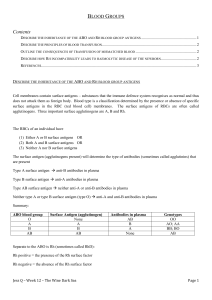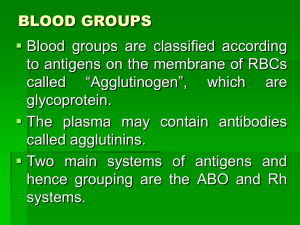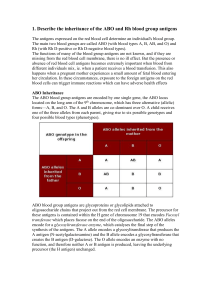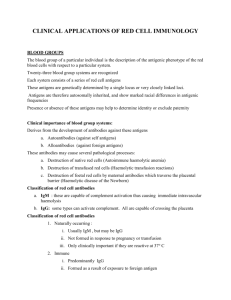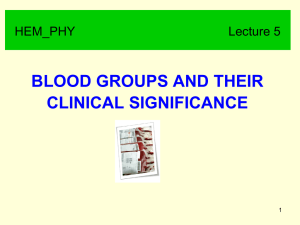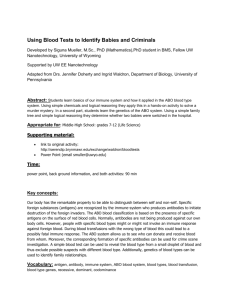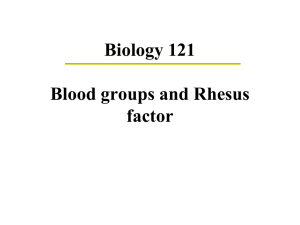BLOOD AND BLOOD COMPONENTS
advertisement
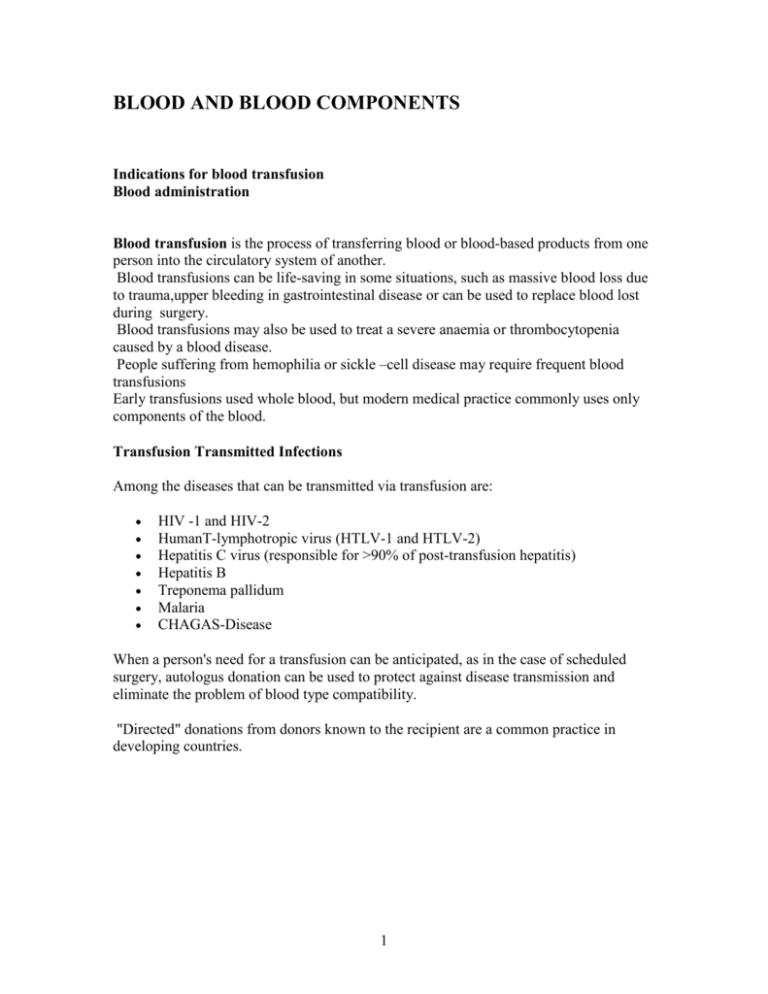
BLOOD AND BLOOD COMPONENTS Indications for blood transfusion Blood administration Blood transfusion is the process of transferring blood or blood-based products from one person into the circulatory system of another. Blood transfusions can be life-saving in some situations, such as massive blood loss due to trauma,upper bleeding in gastrointestinal disease or can be used to replace blood lost during surgery. Blood transfusions may also be used to treat a severe anaemia or thrombocytopenia caused by a blood disease. People suffering from hemophilia or sickle –cell disease may require frequent blood transfusions Early transfusions used whole blood, but modern medical practice commonly uses only components of the blood. Transfusion Transmitted Infections Among the diseases that can be transmitted via transfusion are: HIV -1 and HIV-2 HumanT-lymphotropic virus (HTLV-1 and HTLV-2) Hepatitis C virus (responsible for >90% of post-transfusion hepatitis) Hepatitis B Treponema pallidum Malaria CHAGAS-Disease When a person's need for a transfusion can be anticipated, as in the case of scheduled surgery, autologus donation can be used to protect against disease transmission and eliminate the problem of blood type compatibility. "Directed" donations from donors known to the recipient are a common practice in developing countries. 1 Processing of blood prior to transfusion Donated blood is usually subjected to processing after it is collected, to make it suitable for use in specific patient populations. Examples include: Component separation: red cells, plasma and platelets are separated into different containers and stored in appropriate conditions so that their use can be adapted to the patient's specific needs. Red cells work as oxygen transporters, Plasma is used as a supplement of coagulation factors, Platelets are transfused when their number is very scarce or their function severely impaired. Blood components are usually prepared by centrifugation. Leukoreduction, also known as Leukodepletion is the removal of white blood cells from the blood product by filtration. Leukoreduced blood is less likely to cause alloimunuzation (development of antibodies against specific blood types), and less likely to cause febrile transfusion reactions. o Chronically transfused patients o Potential transplant recipients o Patients with previous febrile nonhemolytic transfusion reaction o Patients with hereditary immune deficiencies o Patients receiving blood transfusions from relatives in directed-donation programs Blood donation Blood is most commonly donated as by inserting a catheter into a vein and collecting it in a plastic bag (mixed with anticoagulant) via gravity. Collected blood is then separated into components to make the best use of it. Aside from red blood cells, plasma, and platelets, the resulting blood component products also include albumin protein, clotting factor concentrates, cryoprecipitate, fibrinogen concentrate, and immunoglobulins (antibodies). In developed countries, donations are usually anonymous to the recipient, but products in a blood bank are always individually traceable through the whole cycle of donation, testing, separation into components, storage, and administration to the recipient. 2 Human blood group systems Blood is composed of cells suspended in a liquid. The liquid portion is the plasma, from which therapeutic fractions and derivatives are made. Suspended in the plasma are three types of cells: Red cells carry oxygen White cells fight infection Platelets stop bleeding in injuries The most common type of grouping is the ABO grouping. Red Blood Cells have a protein coat on their surface which distinguishes them. According to this blood is divided into four groups: A (A oligosaccharide present) B (B oligosaccharide is present) AB (A and B oligosaccharides are present) O (neither A nor B, only their precursor H oligosaccharide present) There are subtypes under this grouping (listed as A1, A2, A1B or A2B…) some of which are quite rare. Apart from this there is a protein which plays an important part in the grouping of blood. This is called the Rh factor. If this is present, the particular blood type is called positive. If it is absent, it is called negative. 3 Blood type Blood type (or blood group) is determined, in part, by the ABO blood group antigens present on red blood cells. A blood type (also called a blood group) is a classification of blood based on the presence or absence of inherited antigenic substances on the surface of red blood cells (RBCs). These antigens may be proteins, carbohydrates, glycoproteins, or glycolipids, depending on the blood group system. Some of these antigens are also present on the surface of other types of cells of various tissues. A total of 30 human blood group systems are now recognized by the International Society of Blood Transfusion 4 ABO and Rh blood grouping Agglutination of blood cells tested with antibodies for determination of blood type in the laboratory. The discovery of this type of agglutination was an important medical breakthrough. ABO blood group system ABO blood group system - diagram showing the carbohydrate chains that determine the ABO blood group The ABO system is the most important blood-group system in human-blood transfusion. The associated anti-A antibodies and anti-B antibodies are usually "Immunoglobulin M", abbreviated IgM, antibodies. ABO IgM antibodies are produced in the first years of life by sensitization to environmental substances such as food, bacteria, and viruses. Rh blood group system The Rh system is the second most significant blood-group system in human-blood transfusion with currently 50 antigens. The most significant Rh antigen is the D antigen because it is the most immunogenic of the five main rhesus antigens. Blood group B has its highest frequency in Northern India and neighboring Central Asia, and its incidence diminishes both towards the west and the east, falling to single digit percentages in Spain. It is believed to have been entirely absent from Native American and Australian Aboriginal populations prior to the arrival of Europeans in those areas. 5 Blood group A is associated with high frequencies in Europe, especially in Scandinavia and Central Europe, although its highest frequencies occur in some Australian Aborigine populations and the Blackfoot Indians of Montana. Other blood group systems The International Society of Blood Transfusion currently recognizes 30 blood-group systems (including the ABO and Rh systems). Thus, in addition to the ABO antigens and Rh antigens, many other antigens are expressed on the RBC surface membrane. For example, an individual can be AB, D positive, and at the same time M and N positive (MNS system), K positive (Kell system), Lea or Leb negative (Lewis system), and so on, being positive or negative for each blood group system antigen. Main symptoms of acute hemolytic reaction due to blood type mismatch. -chills,fever -hypotension,uncontrollable bleeding -heat sensation -pain in lumbar region -increased heart rate -constricting pain -urinary hemoglobinuria,hyperbilirubinemia If a unit of incompatible blood is transfused between a donor and recipient, a severe acute hemolytic reaction with hemolysis (RBC destruction), renal failure and shock is likely to occur, and death is a possibility. Antibodies can be highly active and can attack RBCs and bind components of the complement system to cause massive hemolysis of the transfused blood. Patients should ideally receive their own blood or type-specific blood products to minimize the chance of a transfusion reaction. Rare blood types can cause supply problems for blood banks and hospitals . 6 Blood products In order to provide maximum benefit from each blood donation and to extend shelf-life, blood banks fractionate some whole blood into several products. The most common of these products are packed RBCs, plasma, platelets, cryoprecipitate, and fresh frozen plasma (FFP). FFP is quick-frozen to retain the labile clotting factors V and VIII, which are usually administered to patients who have a potentially fatal clotting problem caused by a condition such as advanced liver disease, overdose of anticoagulant, or disseminated intravascular coagulation (DIC). Units of packed red cells are made by removing as much of the plasma as possible from whole blood units. Clotting factors synthesized by modern recombinant methods are now in routine clinical use for hemophilia. Blood group AB individuals have both A and B antigens on the surface of their RBCs, and their blood serum does not contain any antibodies against either A or B antigen. Therefore, an individual with type AB blood can receive blood from any group (with AB being preferable), but can donate blood only to another type AB individual. Blood group A individuals have the A antigen on the surface of their RBCs, and blood serum containingIgM antibodies against the B antigen. Therefore, a group A individual can receive blood only from individuals of groups A or O (with A being preferable), and can donate blood to individuals with type A or AB. Blood group B individuals have the B antigen on the surface of their RBCs, and blood serum containing IgM antibodies against the A antigen. Therefore, a group B individual can receive blood only from individuals of groups B or O (with B being preferable), and can donate blood to individuals with type B or AB. 7 Blood group O (or blood group zero in some countries) individuals do not have either A or B antigens on the surface of their RBCs, but their blood serum contains IgM anti-A antibodies and anti-B antibodies against the A and B blood group antigens. Therefore, a group O individual can receive blood only from a group O individual, but can donate blood to individuals of any ABO blood group (ie A, B, O or AB). If anyone needs a blood transfusion in a dire emergency, and if the time taken to process the recipient's blood would cause a detrimental delay, O Negative blood can be issued. Blood substitutes (also called artificial blood or blood surrogates) are used to fill fluid volume and/or carry oxygen and other blood gases in the cardiovascular system commonly used, the term is not accurate since human blood performs many important functions which blood substitutes may not. Examples of these two "blood substitute" categories: Volume expanders: inert and merely increase blood volume. These may be crystalloid-based (Ringer s lactate,normal saline )D5W (dextrose 5% in water) or colloid-based (voluven,gelofusin). Oxygen therapeutics: mimic human blood's oxygen transport ability. Hemopure, Oxygent, Polyheme.. Oxygen therapeutics are in turn broken into two categories based on transport mechanism: perfluorocarbon based, and hemoglobin based. Volume expanders are widely available and are used in both hospitals and first response situations by paramedics and emergency teams 8


